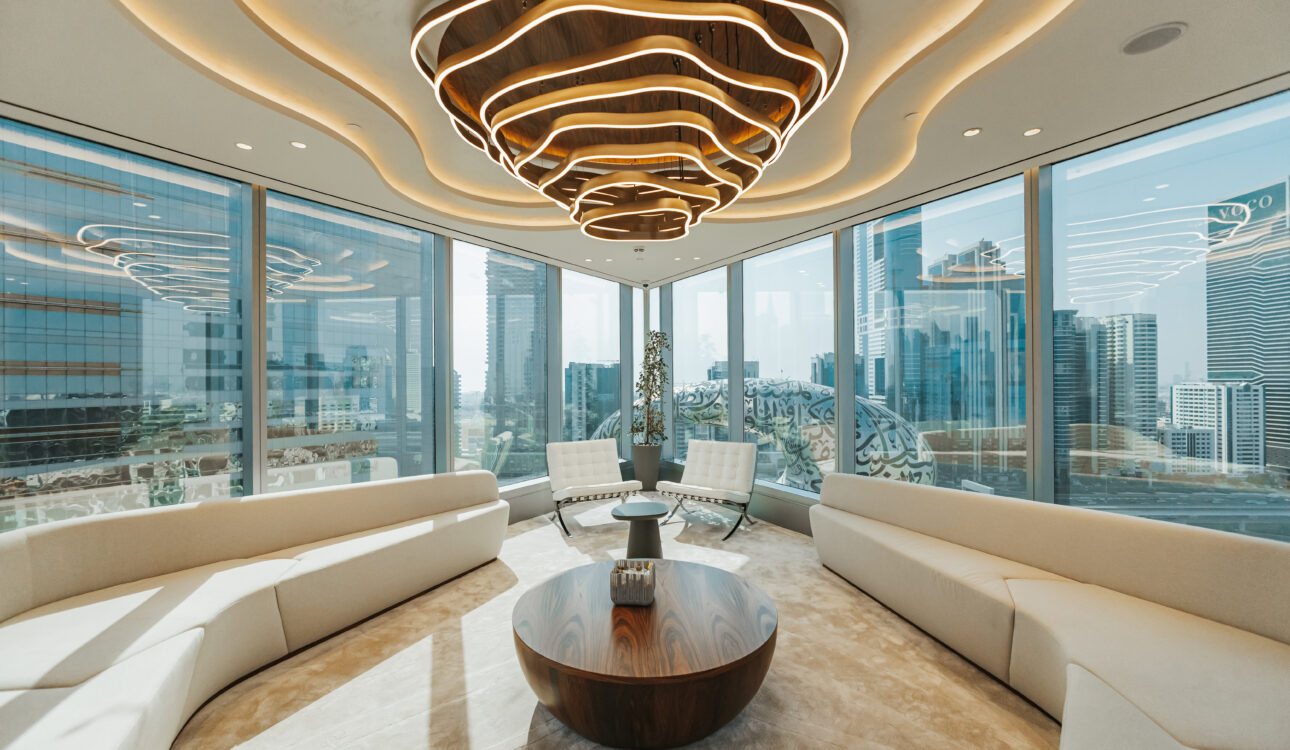Introduction
The Benefits of Natural Materials in Office Design: In recent years, the integration of natural materials in office design has become a significant trend. Natural materials, such as wood, stone, bamboo, and plants, are increasingly used to create more sustainable, healthy, and aesthetically pleasing work environments. This shift is driven by a growing awareness of the importance of environmental sustainability, employee well-being, and the overall aesthetic and functional benefits these materials provide.
Historical Context
The evolution of office design & fitout has seen various trends and shifts over the decades. In the past, office spaces were often characterized by sterile, utilitarian designs focused primarily on functionality. However, as the understanding of workplace dynamics evolved, so did the design principles. The use of natural materials has played a pivotal role in this transformation, bringing warmth, beauty, and a connection to nature into the work environment.
Historically, the use of natural materials can be traced back to traditional craftsmanship where wood, stone, and natural fibers were prevalent. With the industrial revolution, there was a shift towards synthetic and mass-produced materials. However, in recent decades, there has been a resurgence in the use of natural materials, influenced by movements such as biophilic design and sustainable architecture.
Types of Natural Materials Used in Office Design
- Wood: Known for its warmth and versatility, wood is used in furniture, flooring, and wall panels.
- Stone: Adds a sense of solidity and timelessness, often used in flooring and countertops.
- Bamboo: A sustainable alternative to wood, used in flooring and decorative elements.
- Natural Fibers: Includes materials like cotton, wool, and jute, used in textiles and upholstery.
- Plants and Greenery: Integrates living elements into the workspace, enhancing air quality and aesthetic appeal.
Benefits of Using Natural Materials in Office Design
Health Benefits
Improved Air Quality
Natural materials often contribute to better indoor air quality by reducing the presence of harmful chemicals found in synthetic materials. For example, wood and natural fibers emit fewer volatile organic compounds (VOCs), creating a healthier breathing environment.
Stress Reduction
The inclusion of natural elements in office design is rooted in the concept of biophilic design, which emphasizes the human connection to nature. Natural materials help reduce stress levels and create a calming environment, enhancing employee well-being and productivity.
Enhanced Well-being
Offices designed with natural materials often see increased productivity and better overall well-being among employees. Natural light, ventilation, and the presence of greenery can contribute to improved mental and physical health, fostering a more positive work atmosphere.
Environmental Benefits
Sustainability
Natural materials are typically more sustainable compared to synthetic alternatives. Materials like bamboo and wood can be sourced from renewable resources and processed using eco-friendly methods, reducing the environmental impact.
Reduced Carbon Footprint
Using natural materials can also contribute to a lower carbon footprint for office buildings. Many natural materials require less energy to produce and can often be sourced locally, minimizing transportation emissions.
Aesthetic and Functional Benefits
Enhanced Aesthetic Appeal
Natural materials bring a unique beauty to office spaces, with their varied textures, colors, and patterns. They offer versatility in design, allowing for the creation of both modern and traditional aesthetics that are visually pleasing and inviting.
Durability and Longevity
Natural materials such as stone and hardwood are known for their durability. They can withstand heavy use and age gracefully, making them cost-effective choices in the long run due to their longevity and minimal maintenance requirements.
Acoustic Properties
Natural materials like wood and natural fibers have excellent sound absorption qualities, which help reduce noise levels in office environments. This creates quieter workspaces that can enhance concentration and productivity.
Challenges and Solutions
Higher Initial Costs
While natural materials can be more expensive upfront compared to synthetic options, their durability and low maintenance costs often result in long-term savings.
Maintenance and Upkeep
Natural materials may require specific maintenance to retain their appearance and functionality. Solutions include using protective coatings and regular cleaning routines to preserve their beauty and integrity.
Availability and Sourcing
Sourcing high-quality, sustainable natural materials can be challenging. Partnering with reputable suppliers and focusing on locally-sourced materials can mitigate these issues.
Future Trends in Office Design with Natural Materials
Increasing Use of Sustainable Materials
The trend towards sustainability is likely to continue, with more offices incorporating eco-friendly materials like reclaimed wood and recycled textiles.
Integration of Technology with Natural Elements
Future office designs will increasingly blend technology with natural elements, such as smart lighting systems that mimic natural daylight and energy-efficient HVAC systems integrated with natural ventilation.
Future of Biophilic Design
Biophilic design, which integrates natural elements to improve well-being, will continue to evolve. Future trends may include more sophisticated indoor gardens and the use of natural materials in innovative ways to create holistic work environments.
Expert Insights
Quotes from Designers and Architects
Leading designers and architects emphasize the importance of natural materials in creating sustainable and health-promoting workspaces. Their insights highlight the benefits of integrating nature into office design and the positive impact on employee well-being.
Industry Opinions on Trends
Experts predict that the demand for natural materials in office design will grow as companies recognize their benefits. They also foresee advancements in sustainable materials and biophilic design principles shaping the future of office spaces.
Recommendations for Implementation
Experts recommend starting with small changes, such as incorporating plants and natural light, before undertaking major renovations. They also suggest collaborating with designers who specialize in sustainable and biophilic design.
Personal Stories or Case Studies
Employee Experiences
Employees working in offices designed with natural materials often report higher levels of satisfaction and well-being. Personal stories highlight the positive impact on mental health, productivity, and overall job satisfaction.
Case Studies of Companies Who’ve Adopted Natural Materials
Case studies of companies that have successfully integrated natural materials into their office designs demonstrate the tangible benefits, including improved employee retention, lower absenteeism, and enhanced company culture.
Impact on Work Culture and Productivity
Adopting natural materials in office design can significantly impact work culture by creating a more positive and inspiring environment. This can lead to increased productivity and a stronger sense of community among employees.
Conclusion
The integration of natural materials in office design offers numerous benefits, from improved employee well-being and environmental sustainability to enhanced aesthetic appeal and durability. By understanding and implementing these materials, companies can create healthier, more productive, and sustainable work environments.
Frequently Asked Questions (FAQs)
Q: What are the main benefits of using natural materials in office design?
A: Natural materials improve air quality, reduce stress, enhance well-being, are sustainable, reduce carbon footprint, and add aesthetic and functional value to office spaces.
Q: How do natural materials impact employee well-being?
A: Natural materials contribute to better air quality, reduce stress through biophilic design, and create environments that boost productivity and overall mental and physical health.
Q: Are natural materials more expensive to use in office design?
A: While the initial cost can be higher, natural materials often prove to be cost-effective in the long run due to their durability
and lower maintenance requirements.
Q: How can companies source sustainable natural materials?
A: Companies can partner with reputable suppliers, prioritize locally-sourced materials, and ensure that the materials are certified by sustainability standards.
Q: What are some examples of natural materials used in office design?
A: Examples include wood, stone, bamboo, natural fibers like cotton and wool, and living plants and greenery integrated into the workspace.






